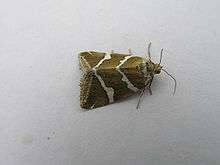Deltote bankiana
| Deltote bankiana | |
|---|---|
 | |
| Scientific classification | |
| Kingdom: | Animalia |
| Phylum: | Arthropoda |
| Subphylum: | Hexapoda |
| Class: | Insecta |
| Order: | Lepidoptera |
| Family: | Noctuidae |
| Genus: | Deltote |
| Species: | D. bankiana |
| Binomial name | |
| Deltote bankiana Fabricius, 1775 | |
Deltote bankiana, the silver barred, is a species of moth of the family Noctuidae. It is found in the Palearctic.
The range of the species stretches from the Iberian peninsula and France in the West to Japan and Korea in the East. However, the occurrences are often only isolated. In England, it is found in Cambridgeshire and Kent elsewhere in England the species is a regular immigrant.In Ireland it is resident in peat bogs in County Cork and County Kerry. in the North, the range is from South Sweden. In the South, it is absent from Greece.In the Alps, bankiana rises to 1500 meters.
Description
The wingspan is 24–28 mm. The length of the forewings is 10–12 mm. "Forewing pale olive brown,sometimes sprinkled with darker brown; the markings shining white, edged with blackish; viz., a small spot at base of costa, two narrow outwardly oblique transverse fasciae, a short costal mark before apex, and a straight subterminal streak; reniform stigma indicated by a swelling in second fascia; hindwing luteous white, sprinkled with grey, deeper terminally. Staudinger describes the form amurula from Amurland as rather smaller than typical olivana and darker brown; redbrown specimens are occasionally taken in England, ab. rufescens Tutt;-—in obsoleta Tutt the oblique white lines are much attenuated and the reniform stands by itself; — in oblitescens Schultz the white bands are abbreviated, one or the other not reaching the margins; - in confluens Schultz the white bands are either connected laterally by a cross streak or are approximated to form one complete or semi-complete broad white band; these last two forms are from Silesia; I have seen nothing like this development in British specimens.[1]
Biology
The moth flies from May to August depending on the location. The moth flies both at night as during the day.
Larva yellow green; dorsal line darker; subdorsal lines yellow; head green; The larvae feed on various grasses and Carex [2]
References
- ↑ Seitz, A. Ed., 1914 Die Großschmetterlinge der Erde, Verlag Alfred Kernen, Stuttgart Band 3: Abt. 1, Die Großschmetterlinge des palaearktischen Faunengebietes, Die palaearktischen eulenartigen Nachtfalter, 1914
- ↑ "Robinson, G. S., P. R. Ackery, I. J. Kitching, G. W. Beccaloni & L. M. Hernández, 2010. HOSTS - A Database of the World's Lepidopteran Hostplants. Natural History Museum, London.".
External links
- Lepiforum
- Funet Taxonomy
- Fauna Europaea
- Vlindernet (Dutch)
- waarneming.nl (Dutch)
- Lepidoptera of Belgium
- Silver Barred at UKmoths
| Wikimedia Commons has media related to Deltote bankiana. |